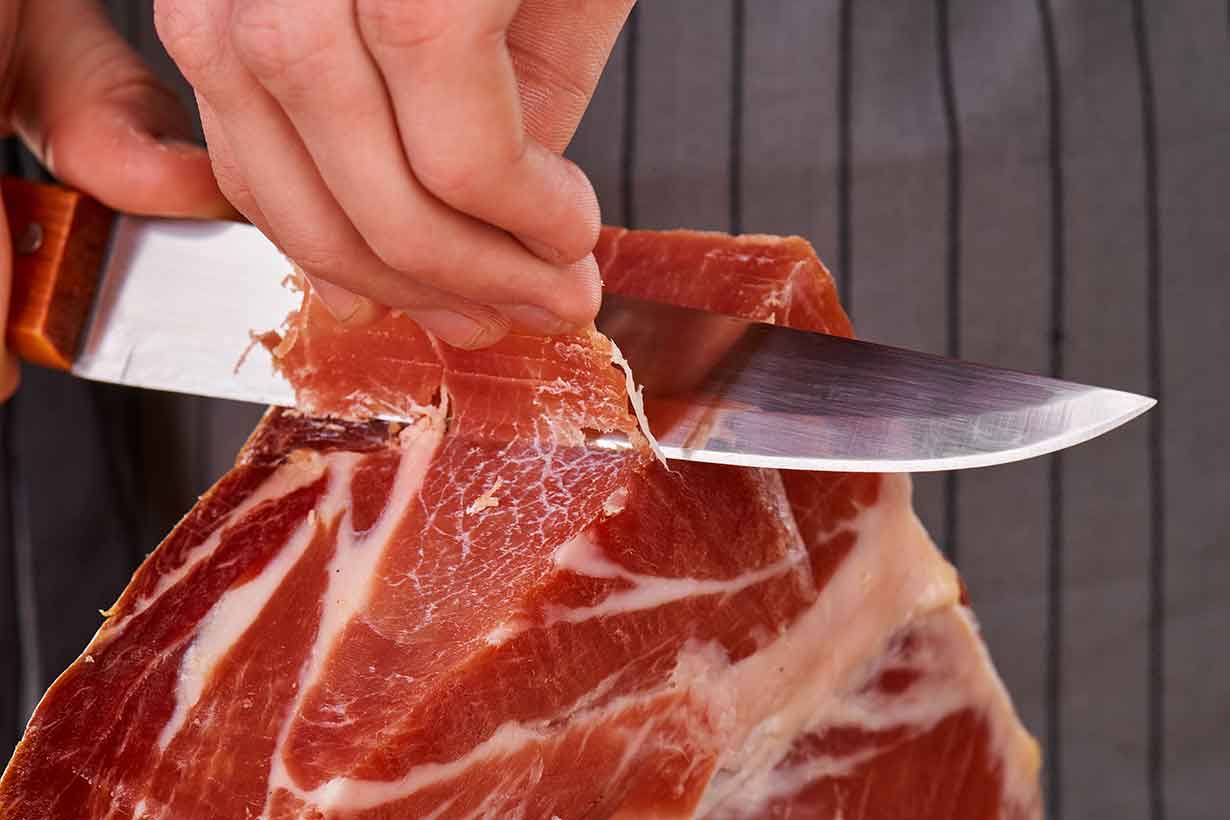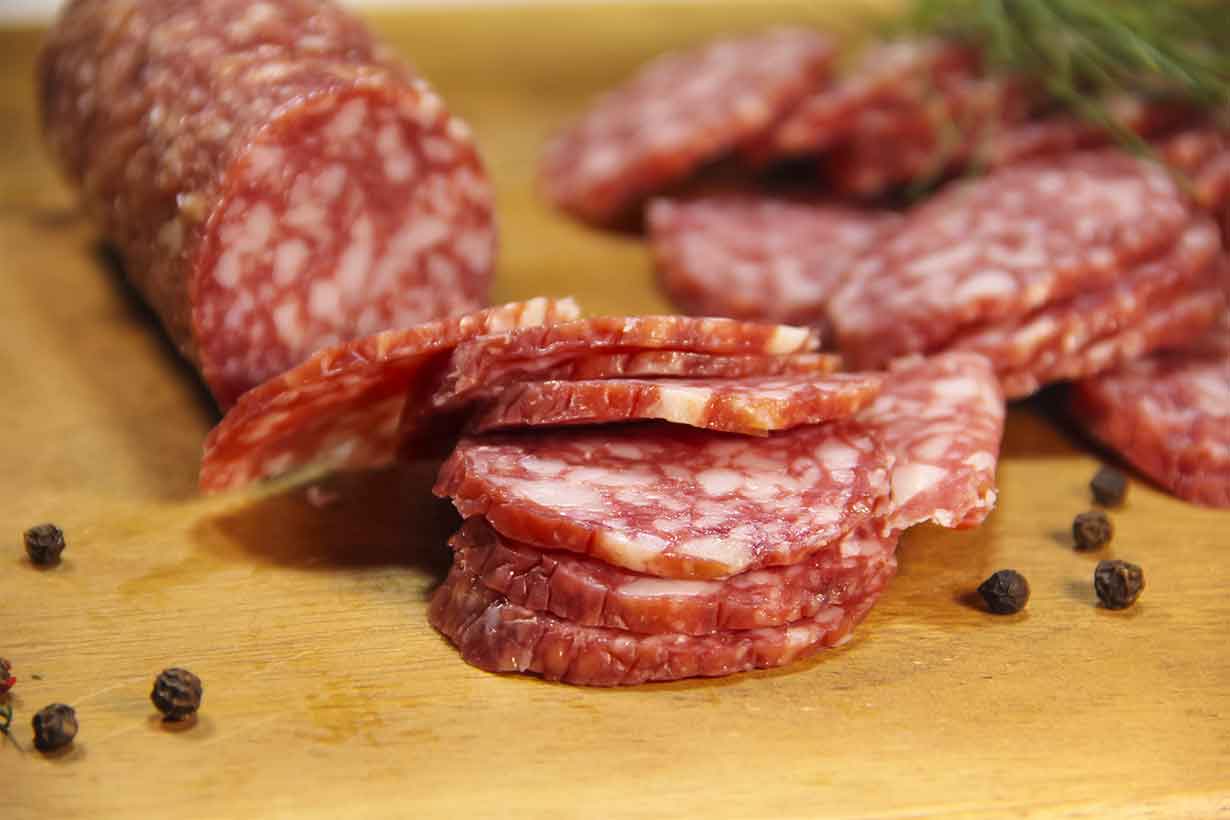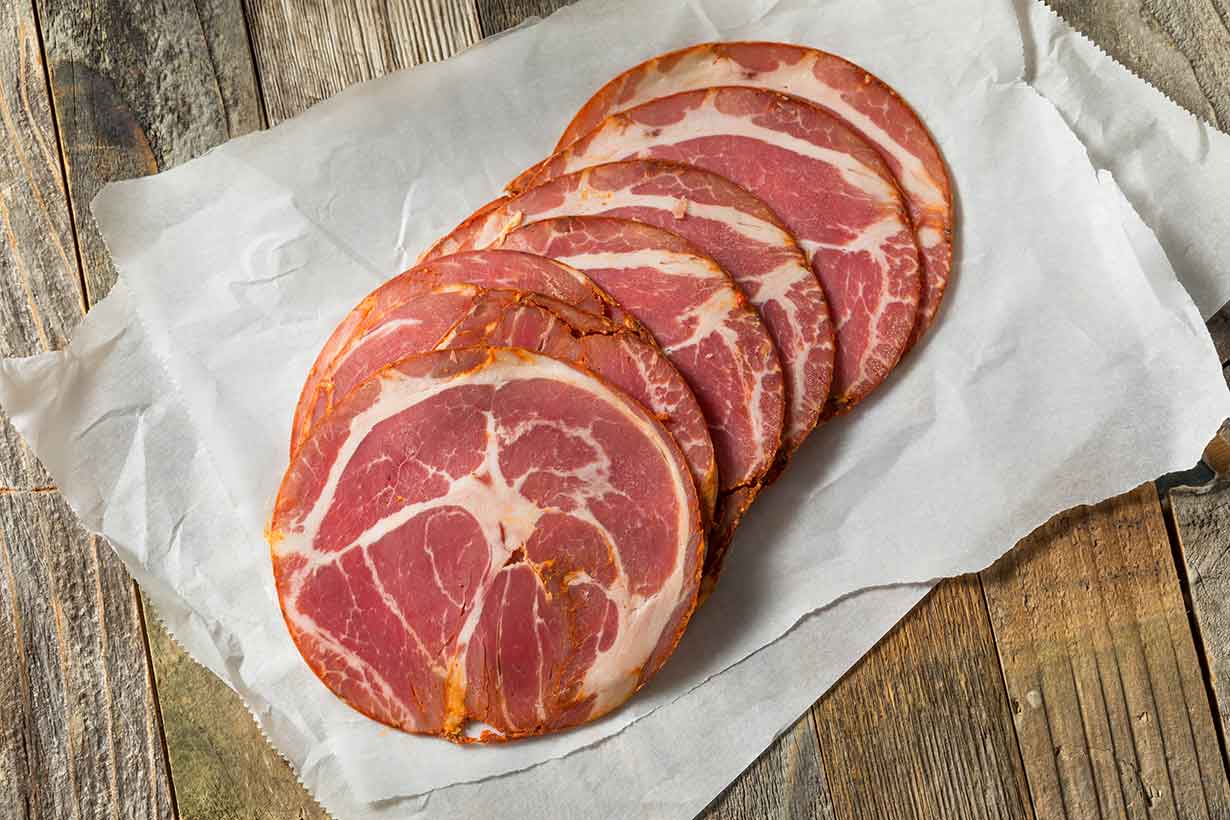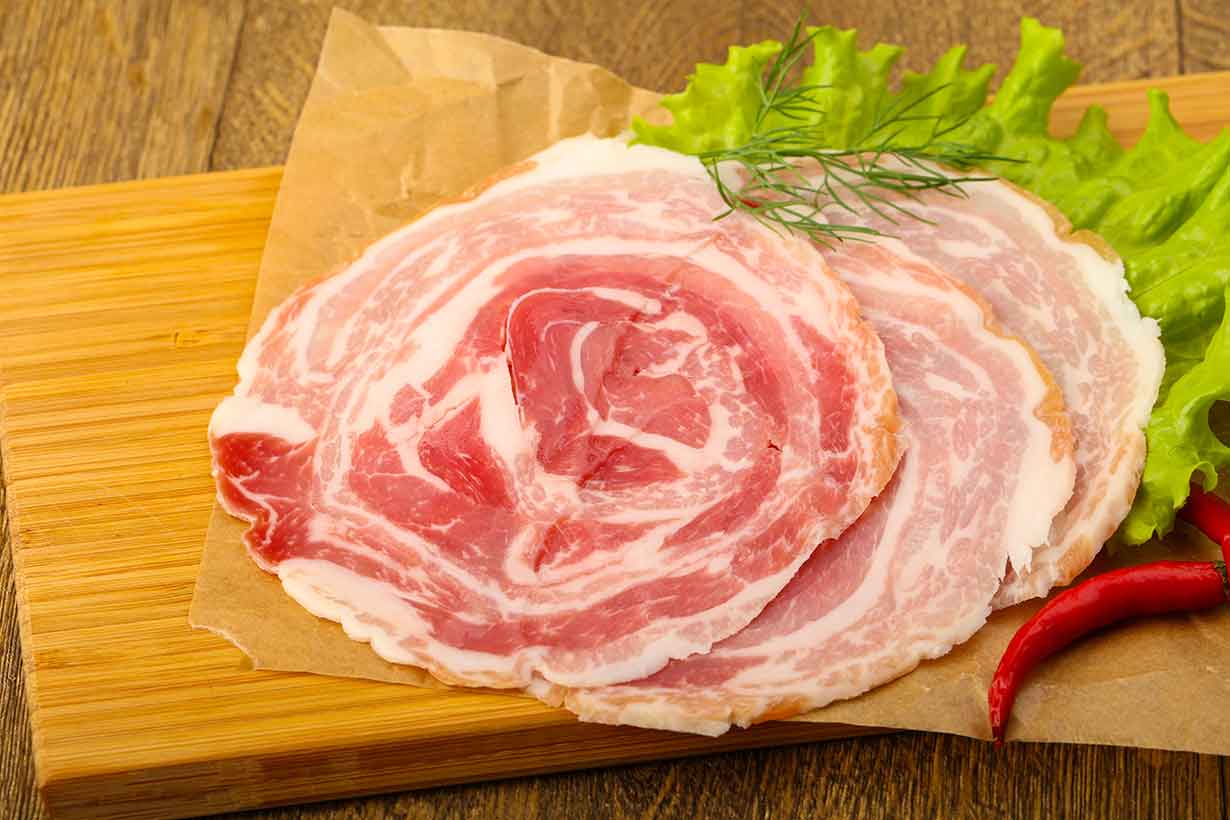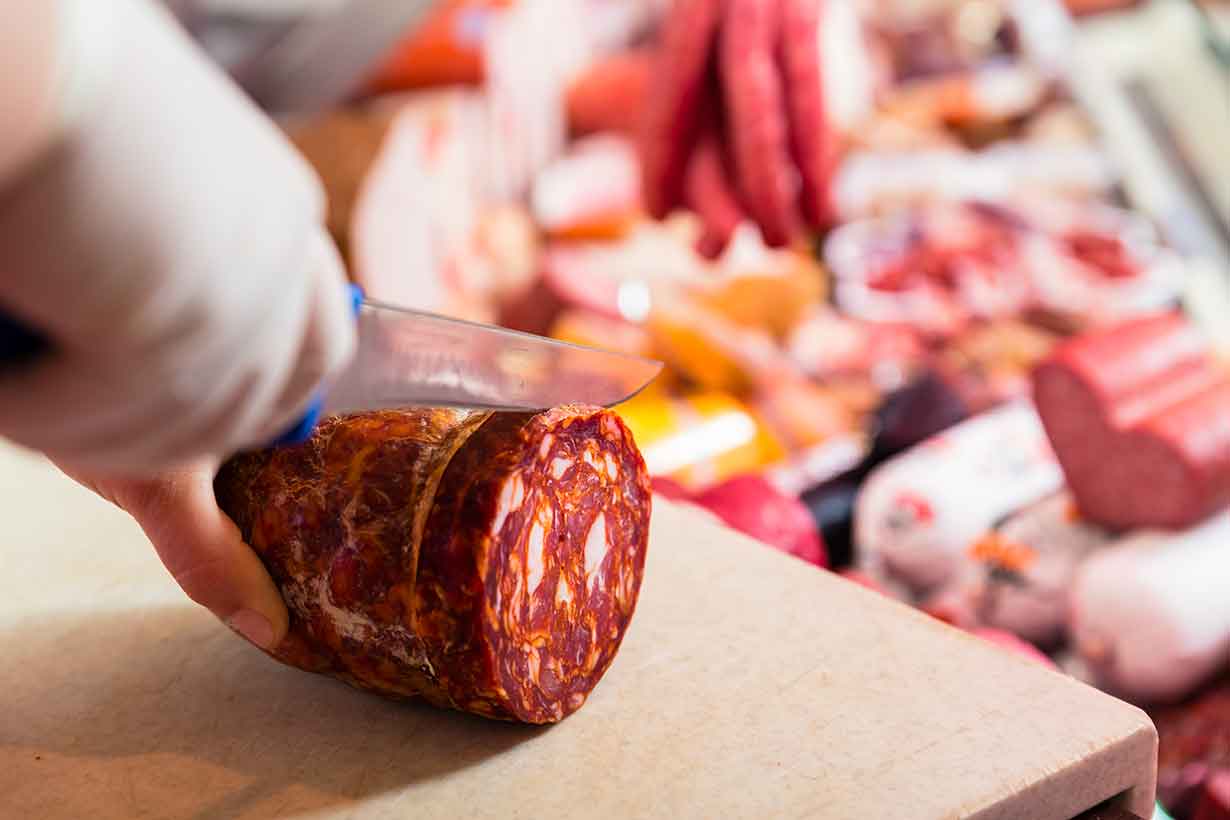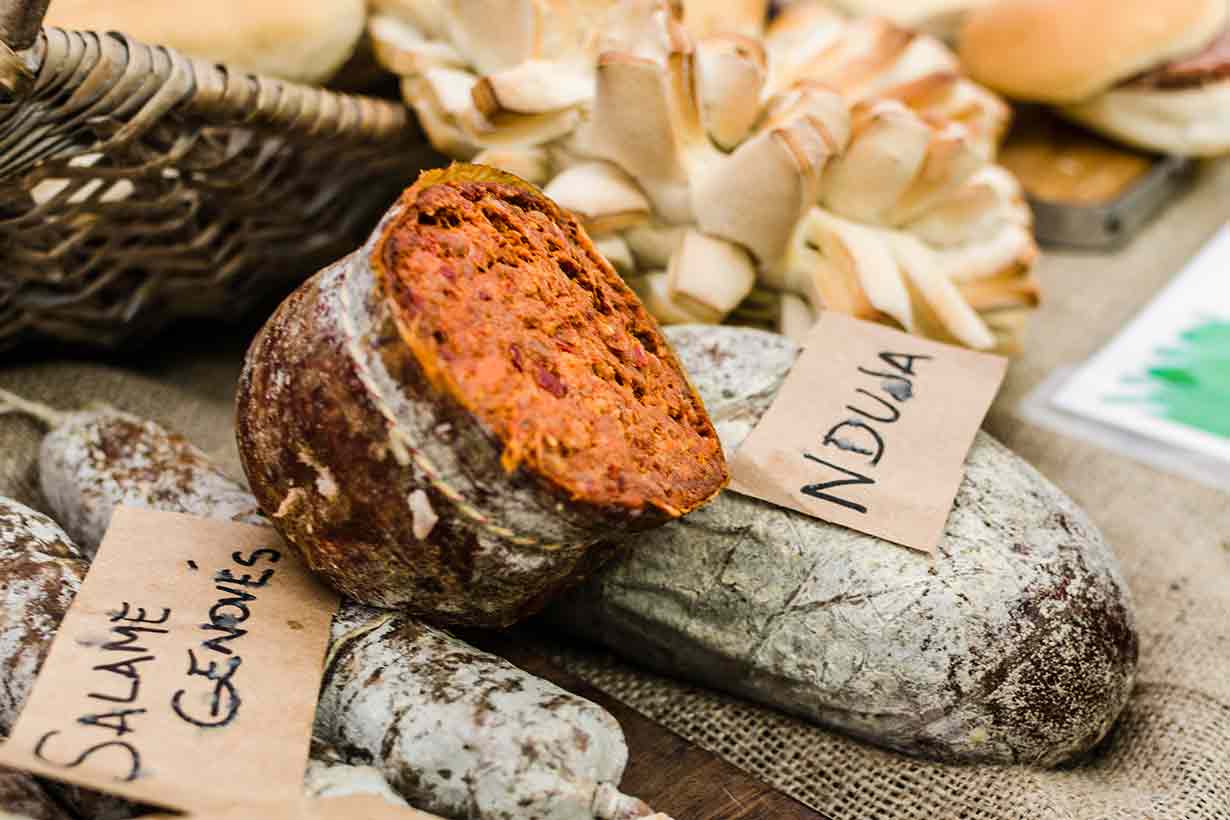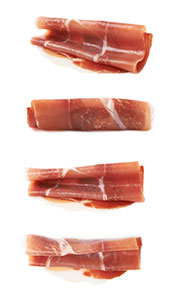
Cured meats have been one of our most traditional foods going back to ancient times.
They are a popular part of Mediterranean diets and often play a starring role in tapas and antipasto dishes.
While you probably already know jamon, prosciutto and salami, there are many other interesting options too.
This article takes a look at 12 different types of cured meat alongside their nutrition facts and profiles.
What is Cured Meat?
Before we delve into the 12 types of cured meats, let’s first examine what cured meat is.
To put it simply; curing involves the salting, drying and aging of meat as a way of preservation, slowing spoilage, and preventing the growth of harmful bacteria.
Before refrigeration, curing was a lot more common (and necessary) than in today’s age of convenience.
In other words; if we didn’t cure out meat, we wouldn’t have had any!
We tend to cure meat in two different ways;
- Traditional: the traditional way of curing was simply to fully cover the cut of meat in salt.
- Modern: Although some producers still use the traditional method, many cured meats now use preservatives called nitrites and nitrates. These preservative salts come in the form of sodium nitrate and potassium nitrate. There is some controversy over the health effects of using these compounds, but that is an article for a different day.
Cured meat tends to have a deeper flavor and softer texture than fresh meat and people sometimes refer to it as ‘cold cuts’.
However, not all cold cuts are cured/fermented, and some are just precooked ham.
Although this isn’t always the case, cured meat usually comes in the form of dry-cured beef/pork sausages (such as salami) or whole muscle meat slices (like prosciutto).
Types of Cured Meat
Now, let’s examine twelve of the best/most popular cured meats.
For each one, you will find information on the history, nutrition profile, and interesting trivia.
1. Cervelat

Cervelat is a kind of cured sausage with origins in Switzerland.
However, it is also produced in some regions of France and Germany.
| Region: | Switzerland (also France, Germany) |
| Ingredients: | Bacon, beef, pork, salt, spices |
History shows that this dry-cured sausage was first mentioned back in the mid-16th century.
At that time, it was made in a very different way and the recipe called for a mixture of beef brains and meat.
In modern times, the ingredients include a tasty mix of bacon, beef and pork alongside various spices for seasoning.
Nutritionally, cervelat provides the following nutrients (1);
- Calories: 362 kcal
- Carbohydrate: 3.3 g
- Fat: 30 g
- Saturated: 12 g
- Monounsaturated: 13 g
- Polyunsaturated: 1.2 g
- Protein: 17.45 g
- Sodium: 1300 mg
Unlike most cured meat, cervelat is often cooked before eating and the sausage is typically boiled, fried or grilled.
2. Chorizo

One of the better-known types of cured meat, chorizo is a Spanish pork sausage with a spicy flavor.
Similar to cervelat, chorizo has a long history and predates the industrial revolution (2).
| Region: | Spain / Portugal |
| Ingredients: | Pork, pork fat, smoked paprika, salt |
Chorizo has an interesting taste; it is a little bit spicy and very fatty but in a good way.
As shown in the ingredients box chorizo is seasoned with a kind of smoked paprika known as ‘pimenton’.
Pimenton plays a prevalent role in Spanish cuisine, and it is responsible for the red color of chorizo.
Depending on the type of pimenton, chorizo will either be classed as picante or dulce. The former uses spicy paprika while the latter uses a sweet variety.
Traditionally, intestines provide chorizo’s casing.
Since chorizo is made from a mix of pork and lard (pork fat), it has a higher calorie and fat content compared to other cured meats (3).
- Calories: 455 kcal
- Carbohydrate: 1.9 g
- Fat: 38.3 g
- Saturated: 14g
- Monounsaturated: 18 g
- Polyunsaturated: 3.5 g
- Protein: 24.1 g
- Sodium: 1235 mg
3. Coppa

Coppa marks the first entry for an Italian cured meat.
Otherwise known as capocollo, this delicious dry-cured meat uses pork shoulder and a mixture of tasty seasonings.
The pork shoulder is served in thin slices which have a deep flavor.
| Region: | Italy (various regions) |
| Ingredients: | Pork shoulder, red (or white) wine, herbs, spices, salt |
There are several different variants of coppa and all use their place of origin within their name.
In total, coppa is produced in six different Italian regions and each variety is named accordingly;
- Capocollo della Basilicata
- Capocollo di Calabria
- Capocollo del Lazio
- Coppa Piacentina
- Capocollo dell Umbria
- Capocollo tipici senese
As shown above, the varieties of coppa written in bold have Protected Designation of Origin (POD) status under EU law.
Coppa is almost equal parts protein and fat (4);
- Calories: 321.4 kcal
- Carbohydrate: 0 g
- Fat: 21.4 g
- Protein: 28.6 g
- Sodium: 1607 mg
4. Culatello

Culatello is another cured meat originating from Italy and it dates back to the 14th century (5).
The full name includes the region from where it is produced; Culatello di Zibello.
| Region: | Italy (Zibello) |
| Ingredients: | Pork thigh, garlic, pepper, salt, white wine |
Although not as famous internationally as cured meats like prosciutto, culatello has a stellar local reputation.
In fact, the locals refer to it as the “king of cured meats”.
Culatello di Zibello has a mild and slightly sweet flavor which somewhat depends on the aging time – some versions are over three years old.
As you can see in the nutrition profile, culatello is slightly leaner than other cured meats and this shows in the fat (and calorie) content (6);
- Calories: 246.9 kcal
- Carbohydrate: 0 g
- Fat: 17.6 g
- Protein: 28.2 g
- Sodium: 1763 mg
5. Guanciale

Guanciale is a type of cured meat made from pork cheeks.
In fact, the name comes from the Italian word for ‘cheek’, which is ‘guancia’.
| Guanciale Profile | |
| Region: | Central Italy (Lazio and Umbria) |
| Ingredients: | Pork cheeks, salt, spices, sugar |
Once again, this cured meat hails from the country of Italy.
Despite being made from a different part of pork, it slightly resembles pancetta, but it has a more flavorful taste.
On that note, some people refer to it as ‘the belly pork of cured meat’.
Guanciale contains high amounts of fat, so you only need a little as it is very rich (7);
- Calories: 591 kcal
- Carbohydrate: 1.9 g
- Fat: 60.9 g
- Saturated: 22.6g
- Monounsaturated: 29.4 g
- Polyunsaturated: 7.2 g
- Protein: 5.7 g
- Sodium: 3730 mg
6. Jamón

Hailing from Spain and Portugal, Jamón is one of the most famous cured meats in the world.
The word Jamón simply means ‘ham’ in Spanish.
| Region: | Spain and Portugal |
| Ingredients: | Pork leg, salt |
For those that have yet to try it, Jamón has a rich, flavorful and slightly chewy quality.
It is somewhat akin to prosciutto but has a deeper flavor, perhaps on account of the longer curing time.
This is particularly true of Jamón Ibérico which has a curing time of anywhere from 2 years to 5 years.
Notably, there are two distinct variants of Jamón.
The first is Jamón Ibérico and the second is Jamón Serrano.
- Jamón Ibérico: This Jamón uses free-range black Iberian pigs that live on the Spanish/Portugese border and famously eat acorns.
- Jamón Serrano: The second variety of Jamón refers to meat from non-black pigs.
Although these are the most famous versions of the cured meat, there are several other regional varieties too.
Here is the typical nutrition profile for Jamón (8);
- Calories: 200 kcal
- Carbohydrate: 0.4 g
- Fat: 13 g
- Saturated: 4.4g
- Monounsaturated: 6 g
- Polyunsaturated: 1.8 g
- Protein: 20 g
- Sodium: 838 mg
7. Lardo

If you like your meat fatty, then a type of salumi (Italian cold cut) called lardo is just what you are looking for.
Lardo is otherwise known as ‘Lardo di Colonnata’ and ‘Lardo di Arnad’ based on the regions which produce it.
Producers make lardo by curing strips of fatback (pork back fat) in salt and seasoning with various herbs and spices.
| Region: | Italy (multiple regions) |
| Ingredients: | Pork back fat, garlic, rosemary, salt and pepper |
Interestingly, lardo is one of the oldest cured meats around, and historical accounts go back to the Roman times.
Lardo is pure fat, and restaurants traditionally serve it as an antipasto.
As the nutritional profile shows, lardo is exceptionally high in fat (9);
- Calories: 900 kcal
- Carbohydrate: 0 g
- Fat: 100 g
- Protein: 0 g
- Sodium: 1235 mg
8. ‘Nduja

With a name that looks impossible to pronounce, ‘Nduja is a spreadable (and spicy) cured meat from Italy.
| Region: | Italy (Calabria) |
| Ingredients: | Pork belly, shoulder, hot peppers, spices. |
The pronunciation sounds something like ‘en-doo-ya’.
Renowned for its deep and intense flavor, this spicy cured meat is somewhat unique.
Specifically, it is spreadable, and it has a wide range of culinary uses.
For example, chefs use it as a dipping sauce, with bread, as a marinade for meat and even as a pasta sauce or pizza topping.
As ‘Nduja uses pork belly, it has a relatively high fat content which helps create the soft texture (10);
- Calories: 512 kcal
- Carbohydrate: 2.2 g
- Fat: 50.5 g
- Saturated: 18.3 g
- Monounsaturated: 23.4 g
- Polyunsaturated: 5.8 g
- Protein: 12.2 g
- Sodium: 79 mg
See this complete guide to ‘nduja for more information.
9. Pancetta

Since it comes from the same part of the pig, Pancetta is very similar to bacon and pork belly in nutritional terms.
As with so many other cured meats, pancetta comes from nation of Italy.
| Region: | Italy (various regions) |
| Ingredients: | Pork belly, salt, black pepper |
It is possible that you have tried pancetta before – perhaps even without realizing.
For instance, we can often find it in pasta/pizza dishes, and it is sometimes sold alongside cheese.
Like any cured meat that uses pork belly, pancetta has a ‘fatty’ nutrition profile (11);
- Calories: 526 kcal
- Carbohydrate: 0 g
- Fat: 53.7 g
- Saturated: 19.7 g
- Monounsaturated: 25.1 g
- Polyunsaturated: 5.7 g
- Protein: 9.3 g
- Sodium: 1607 mg
This complete guide to pancetta provides a more in-depth look.
10. Prosciutto

Prosciutto is Italy’s answer to Jamón Ibérico, and they share many of the same qualities.
This thinly sliced dry-cured ham comes in several different varieties from the various Italian regions which produce it.
| Region: | Italy (multiple regions) |
| Ingredients: | Pork leg/thigh, salt |
Typically, prosciutto will undergo a curing process that can last anything up to two years.
A good traditional version of the meat should only have two ingredients; pork and salt.
However, some cheaper varieties make use of nitrites as a preservative instead of salt.
Prosciutto has quite a mild taste, and it works well in a range of dishes, or just by itself on a cheese platter.
For a full guide to the origin, manufacture, and health aspects of prosciutto see here;
What is Prosciutto and is It Good or Bad For You?
You will also find information on how to make it at home if that appeals!
- Calories: 269 kcal
- Carbohydrate: 0.3 g
- Fat: 18.3 g
- Protein: 24.1 g
- Sodium: 2000 mg
11. Pepperoni

Pepperoni is a type of salami, and it is the only cured meat on this list to originate from outside of Europe.
For those that don’t know; pepperoni originates in the United States.
Although the origin isn’t fully known, it was an Italian-American idea that became popular before 1930 (12).
| Region: | United States |
| Ingredients: | Cured beef, pork, paprika, chilli pepper. |
Pepperoni is very similar to varieties of salami from Italy. However, there are a few major differences;
- Pepperoni is produced using an artificial casing rather than one made from animal products like salami uses.
- Due to the huge demand, pepperoni is mass-produced and almost always uses nitrite preservatives rather than salt.
Since it uses a combination of paprika and chilli, pepperoni has a very red and spicy appearance.
Notably, it is officially the most popular pizza topping in the United States.
The nutrition profile of pepperoni is very similar to other dry-cured sausages (13);
- Calories: 494 kcal
- Carbohydrate: 0 g
- Fat: 44 g
- Saturated: 15 g
- Monounsaturated: 17 g
- Polyunsaturated: 3.4 g
- Protein: 23 g
- Sodium: 1761 mg
12. Soppressata

Here is one last Italian cured meat to finish; soppressata.
Soppressata is a kind of salami and the way to make it varies wildly from region to region.
There are several varieties of soppressata, but two main products are the best known; Soppressata di Basilicata and Soppressata di Calabria.
| Region: | Italy (mainly the Southern regions) |
| Ingredients: | Pork thigh (sometimes all parts of a pig), red pepper, salt |
Soppressata has a similar taste to other types of salami, but each regional variety is purported to have a unique flavor.
While the most popular varieties of soppressata usually use premium cuts of pork, some varieties follow the nose-to-tail mantra.
For example, Sopressata di Tuscany makes use of pig heads and tongues.
Here is the typical nutrition profile for soppressata (14);
- Calories: 321 kcal
- Carbohydrate: 0 g
- Fat: 25 g
- Protein: 25 g
- Sodium: 1357 mg
Final Thoughts
The twelve options in this article are just some of the cured meats that are available.
There are so many varieties, some of which have roots way back in ancient times.
Additionally, these meats all make a great combination on a cheese platter.
Nutritonally, they provide a similar nutritional profile to regular meat.
However, they can be very high in sodium (and potentially preservatives), so moderation is required. In this regard, the product packaging should list the recommended serving size.

